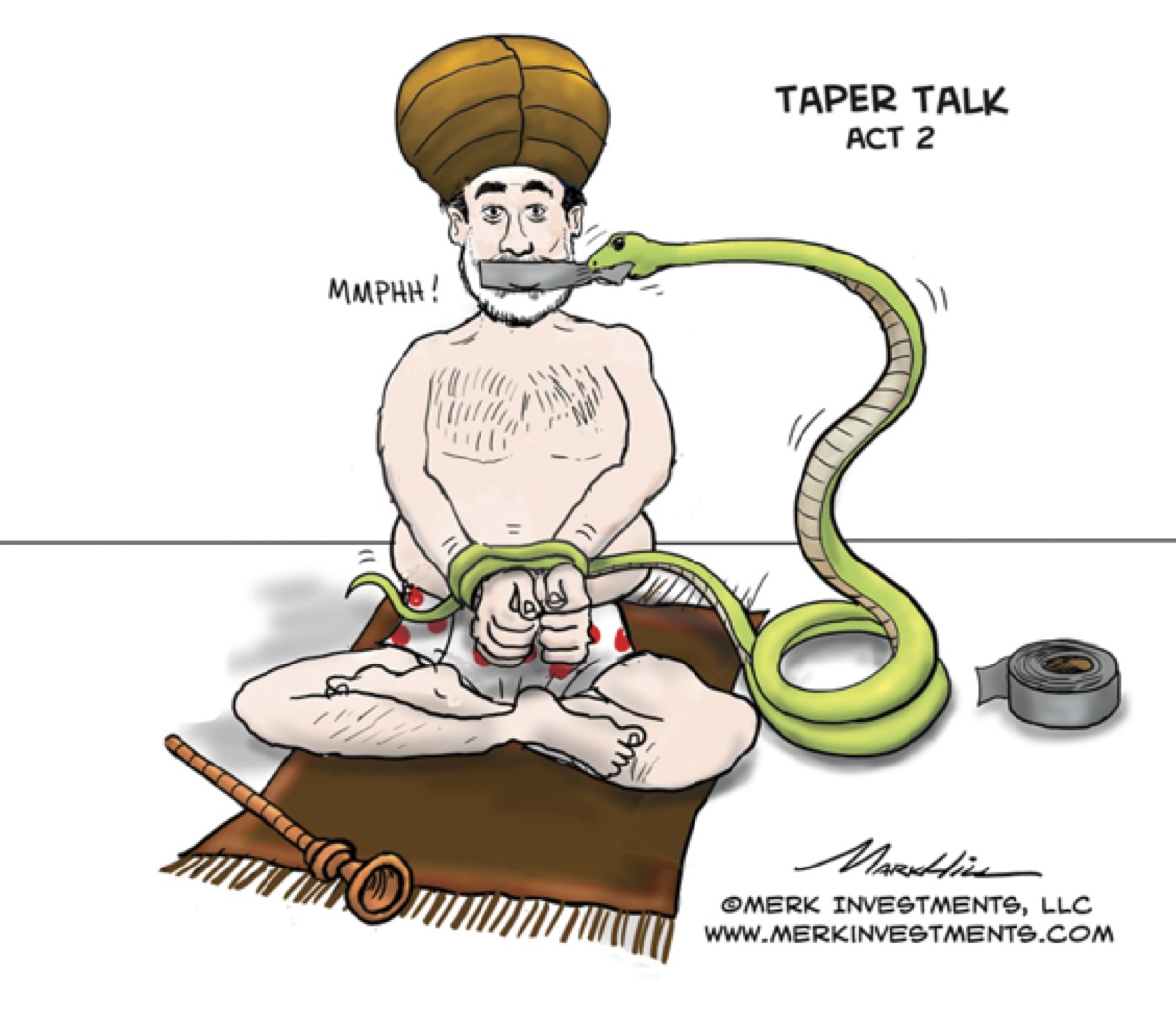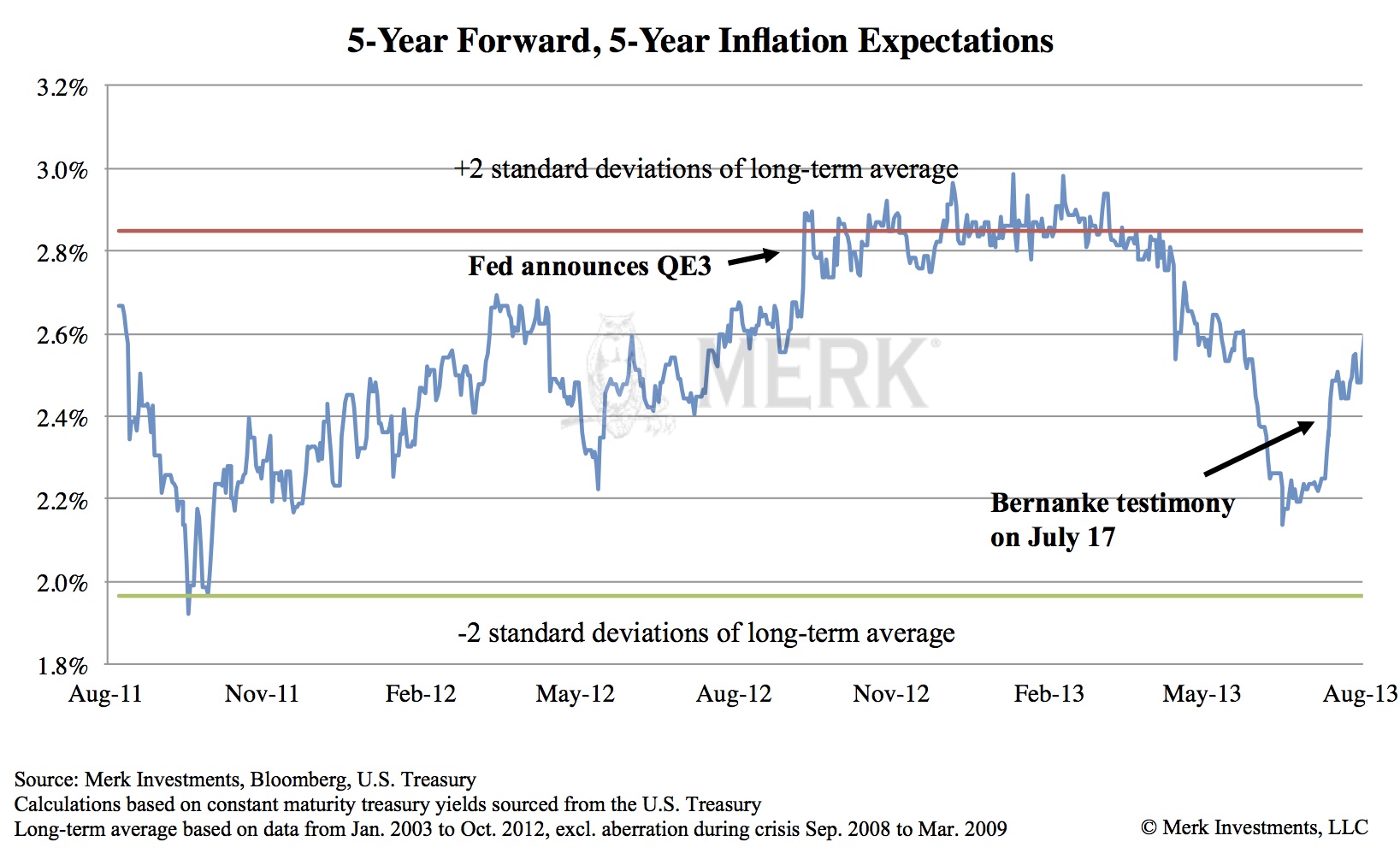Taper Talk, Act 2
Axel Merk, Merk Investments Aug 20th, 2013 While the Fed’s taper talk has been tapered and then un-tapered, the market may now be tapering the Fed rather than vice versa. Let’s assess Act 2 of the taper talk and the implications for the markets, including the dollar and gold.
Earlier this year, when Federal Reserve (Fed) Chair Ben Bernanke first talked about potentially reducing the pace at which the Fed expands its balance sheet (more colloquially known as printing money, even if no actual currency is printed), the market jumped to the conclusion that the end of easy money might be near. Bond prices plunged (yields surged) in the aftermath; the rate on a thirty-year mortgage rose by a full percentage point. The market reaction was all the more violent as the Fed had been depressing yields artificially by: • Communicating low interest rates for an extended period; It should then not come as a surprise that the market acts up at the first sign that the Fed is changing course, even if ever so slightly. But not only was the market surprised at the sharp spike in yields, so was the Fed. Bernanke has since clarified that the only reason he started the taper talk was because of what he perceives to be irrational exuberance in the markets. He neither used the term “taper”, nor “irrational exuberance”, but to us, Bernanke’s July 17, 2013, testimony was the equivalent of Greenspan’s 1996 irrational exuberance speech cautioning of rising valuations in the markets (note that the “irrational market” continued for over three more years after Greenspan’s speech). To give a little more background, in our assessment the Fed introduced additional easing measures in recent years whenever inflation expectations were trending lower. In many ways, the introduction of the “taper talk” was surprising, as those expectations had already been trending lower earlier this year:
Bernanke has suggested this economy might be weaker than headline numbers indicate (suggesting a more accommodative policy for longer). Key metrics of concern include: The reason we focus so much on the Fed is because they control the printing press. Ultimately, however, the Fed is merely a market participant akin to someone sipping with a straw from the ocean. Fed talk works as long as there is confidence in the policy being pursued; and, by the way, talk is cheaper than action. But when the markets start to question the Fed, implementing policy can become very expensive. Traders want to hear little about headache inducing taper talk; all they see is that they may have to sell to themselves rather than to the Fed, as a prominent bond investor recently tweeted. And while pundits tell us that this economy has recovered from the financial crisis, we believe much of the world is addicted to cheap money and remains vulnerable. But how do you wean someone off an addiction? As the Fed is learning, it’s not easy. Most notably, “fine tuning” the process may be all but impossible. In the meantime, as the market is at risk of tantrums, the Fed is focused on its dual mandate to foster price stability and maximum sustainable employment. As market volatility itself is a headwind to economic growth, it’s another indication that the Fed may need to err on the side of easy money. In the meantime, the U.S. Treasury is expected to (on net) issue less debt in the coming months as tax revenue has been higher than expected; separately, fewer mortgage-backed securities (MBS) are being issued as the havoc in the bond market has thrown a monkey wrench into the mortgage origination market. Taken together, the Fed pretty much has to reduce its purchases, not to “taper”, but in order to avoid buying an increasing portion of debt issued by the government. We expect the following implications: We will expand on this discussion in a special webinar on gold this Thursday entitled. Please register to participate in this exclusive webinar entitled “Why I own gold.” Also make sure you subscribe to our newsletter so you know when the next Merk Insight becomes available. Axel Merk
Reader commentaries. To add a commentary, please click here.
|



